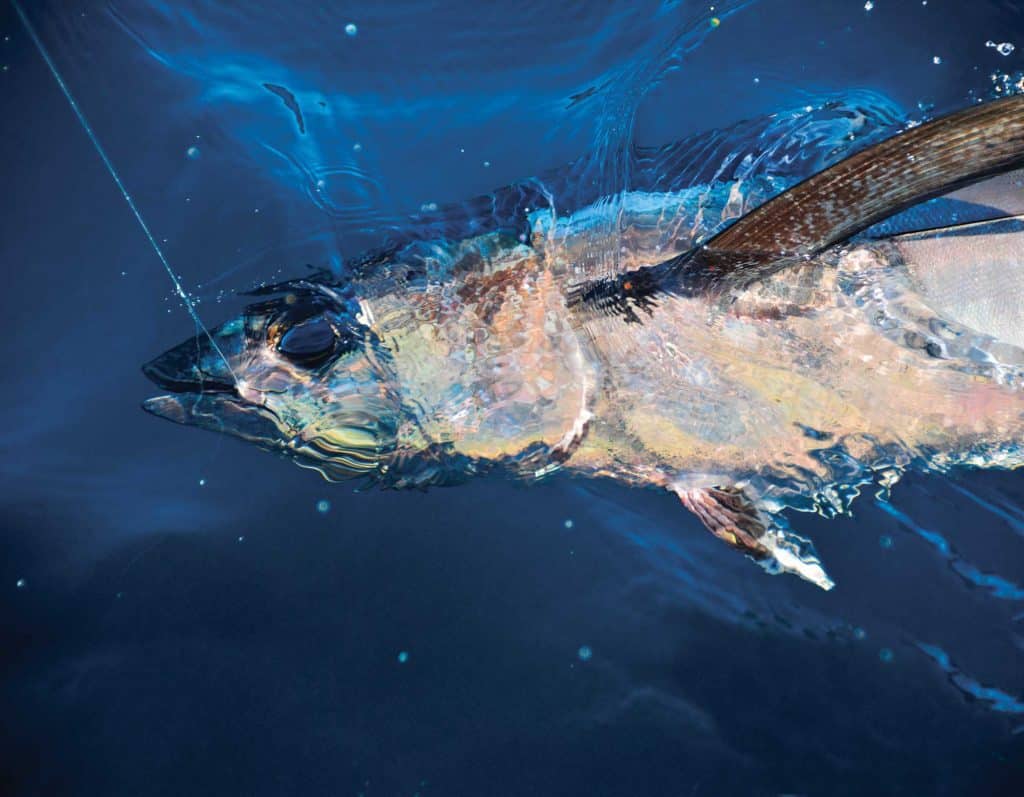
Twenty-two miles astern of the charter boat Shake N Bake, the hamlet of Ilwaco, Washington, had long ago disappeared over the horizon, tucked inside the mouth of the mighty Columbia River. Just ahead we could see the demarcation line where blue-gray nearshore waters meet the Pacific Ocean’s indigo blue. This is Albacore Alley.
As if on cue, about a mile to starboard we barely made out seabirds wheeling and diving into a melee of churning water — a sure sign that tuna were feeding there. Seven eager anglers were all pointing to the obvious, but our skipper, Mike Colbach, had already seen the birds and set an intercept course.
Deckhand Clark Van Essen had two trolling rods ready to deploy with traditional cedar plugs on the business end. The skipper had already given us detailed instruction, but he once again covered the basics over the hum of the twin diesels. “The two of you assigned the trolling rods, get your gear out and get ready!” Colbach shouted. “When you hook up, reel your fish in slowly. We want your hooked fish to help keep the other tuna in the area.
“The rest of you grab an anchovy as soon as we stop. Toss your bait out and let it swim away from the boat,” he continued. “Keep the reel in free-spool with your thumb on the spool. When the line starts peeling off super fast, count to five and slip the drag in gear. No need to set the hook — the tuna will do that for you!”
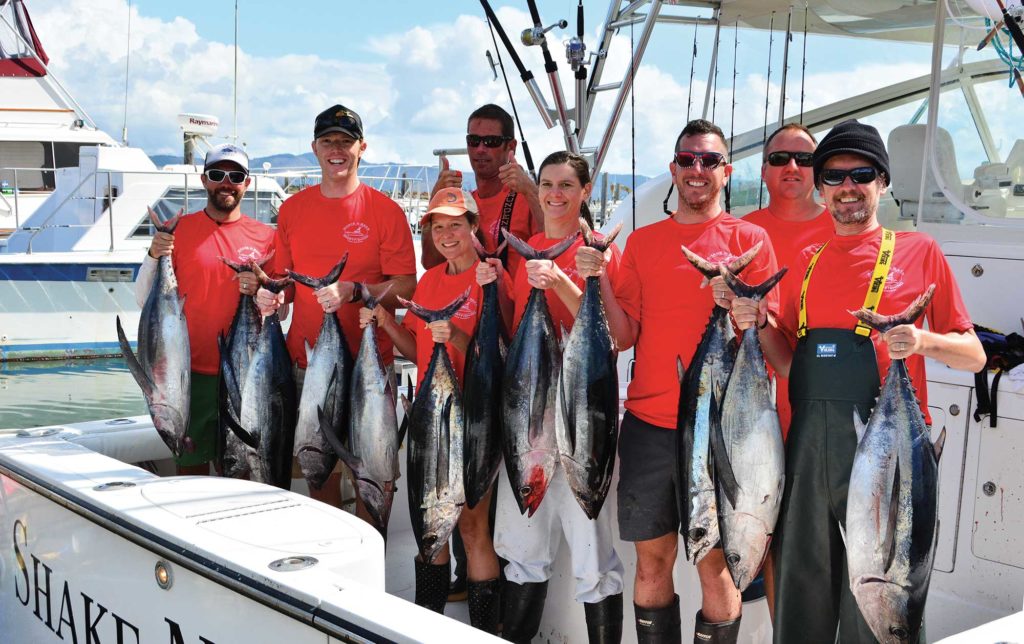
Surrounded by Tuna
As we approached the mass of wheeling birds, an albacore yanked down the starboard rod, the drag wailing like an alarm clock. Seconds later, the port rod did the same. While the two anglers on the trolling rods were fighting their fish, the other five of us crowded around the bait tank, looking for that perfect anchovy that would draw a strike from one of thousands of albacore surrounding our boat. We each cast into the maelstrom while Van Essen chummed with live anchovies to hold the longfin near the boat.
Within seconds, one of the anglers shouted, “I’ve got one!” In response, the deckhand shouted, “Fresh one!” The angler next to me hooked up, and then the guy on my other side did too. It seemed like I was the only one not enjoying the wide-open bite. I exhorted my anchovy, “Swim, you little bastard.” It seemed as if it sped up just a bit. I wondered, “Is he getting nervous?” That’s when line began peeling off my reel like a jet-fuel dragster off the starting line, and I knew I was into one. I counted to five — probably a good deal faster than I was supposed to — then slammed the drag lever forward and joined the fray. Once again Van Essen shouted, “Fresh one!”
Mine did as albacore almost always do: It headed to the bottom at high speed, despite a tight drag. After a 75-yard run, the fish slowed, and I began the give-and-take tug of war that always marks the beginning of the end of a tuna battle. When I had my fish about 30 feet from the surface, I began to see amazing iridescent colors flashing all along its flanks, as well as the oversize pectoral fins that give this species the nickname “longfin.”
“Color!” I shouted, the code word for help in netting a fish. But the deckhand was occupied with three other albacore that were closer than mine. Eventually my turn came, and a 25-plus-pound albacore joined several others on deck. Despite almost incessant washdowns, the stern of Shake N Bake looked like a poorly maintained slaughterhouse. Few fish bleed more easily or profusely than tuna.
Colbach radioed a friend in another boat about three miles away to tell him about our huge school of longfin, but that skipper was also enjoying a wide-open bite. We will never know if we were on a school more than three miles long or if we each had found our own school. No matter. Everyone was having a ball on this day in late July.
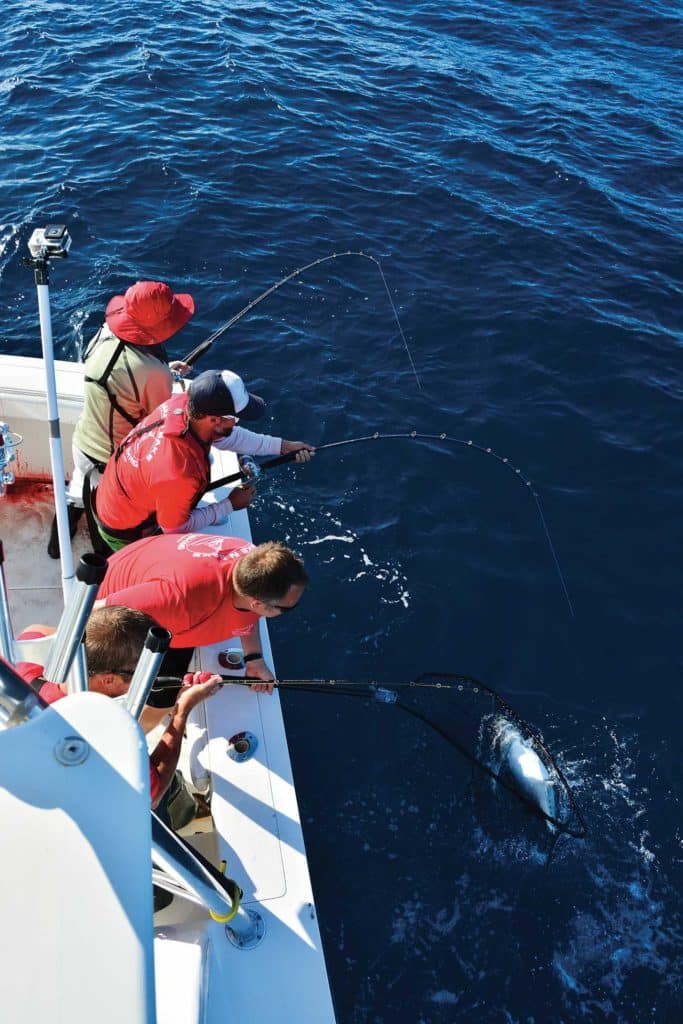
Albacore Background
Albacore have no doubt migrated past the Pacific Northwest coastline for thousands of years, but only recently have anglers had the knowledge and resources to effectively target them. Prior to the 1960s, almost no sport or commercial fishermen targeted them here. They cruised too far offshore, live bait was not available, and the lack of GPS, chart plotters, reliable outboards and fast cruisers made getting to them a dicey proposition.
In the ’70s a few charter boats began offering overnight trips. But the sport really took off in the early 2000s, when a handful of skippers began offering day trips in fast boats that could reach the tuna in as little as two hours.
Today tuna charters are available in several Oregon and Washington ports. Many offer fast boats, plenty of live bait, and the knowledge to consistently put anglers on fish. There are now two tuna tournaments in the Northwest, the Oregon Tuna Classic out of Garibaldi, Oregon, and the Deep Canyon Challenge out of Ilwaco. As many as 70 teams register for these tournaments.
The first tuna sightings in the Pacific Northwest typically occur in late June. They hang around until late October, when the weather usually ends the season. Most albacore caught in Northwest waters are in the 15- to 25-pound range, but some days, 30-pounders are common.
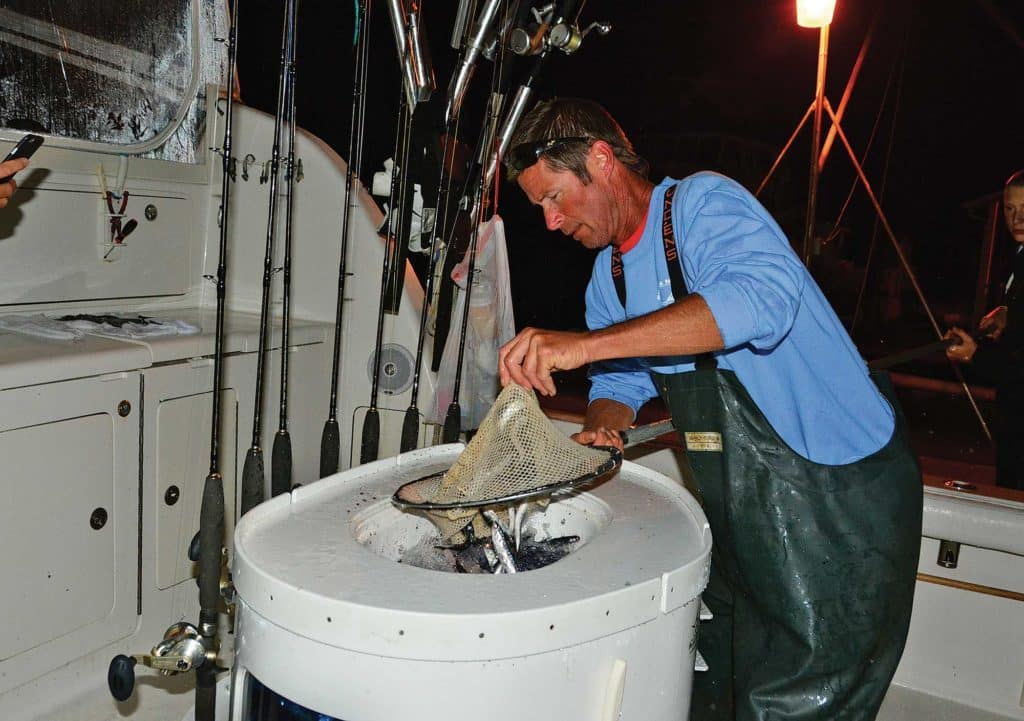
Longfin Lessons
The seven anglers on Shake N Bake were not a typical charter. Rather, Colbach had invited this group of friends to experience what has become an obsession for him. Several in our group were complete novices, and even though the seas were gentle, two had grown seasick by the time we reached blue water. To their credit, no one stopped fishing.
As all good things must, the bite came to an end. The school moved — to where, no one knows. The skipper told us we had to go searching again. As before, two anglers were assigned trolling rods while the rest stood ready. Fortunately, that didn’t take long. The next school was much smaller than the first, however, so not everyone was able to hook up at will as we had earlier.
Colbach, seeing that some folks were struggling, stopped us all for a brief on-the-spot seminar on techniques to improve our odds. He told us that the friskiest anchovies almost always get bit first. He recommended taking our time to find the fastest anchovy in the holding bucket and to hook the live bait very carefully.
The skipper showed us several ways to hook an anchovy to ensure that it would swim aggressively. He also explained that some anchovies tend to swim back under the boat (perhaps the smarter ones?). As hard as it can be to reel in and re-bait when everyone around you is hooked up, that’s exactly what must be done. An anchovy that refuses to head away from the boat will do so every time you cast it. The only solution is to re-bait as quickly as possible.
As soon as our five-minute seminar was over, we went back to fishing. Almost immediately, all around the stern rose cries of “Fresh one!” Several times all seven of us were hooked up.
Once we had about 30 albacore aboard, the skipper explained that while there are no limits on albacore, the boat had a limited amount of storage space for fish. Once the fish holds reached capacity — “plugged,” in the parlance of West Coast tuna fishing — we would have to stop. With typical 25-pound fish, the 42-foot Shake N Bake can hold as many as 50 fish. On this day, a lot of fish were over 30 pounds. Colbach estimated that we could take on 10 to 15 more fish. He asked if we would like to try something different to end the day. Several of us enthusiastically agreed.
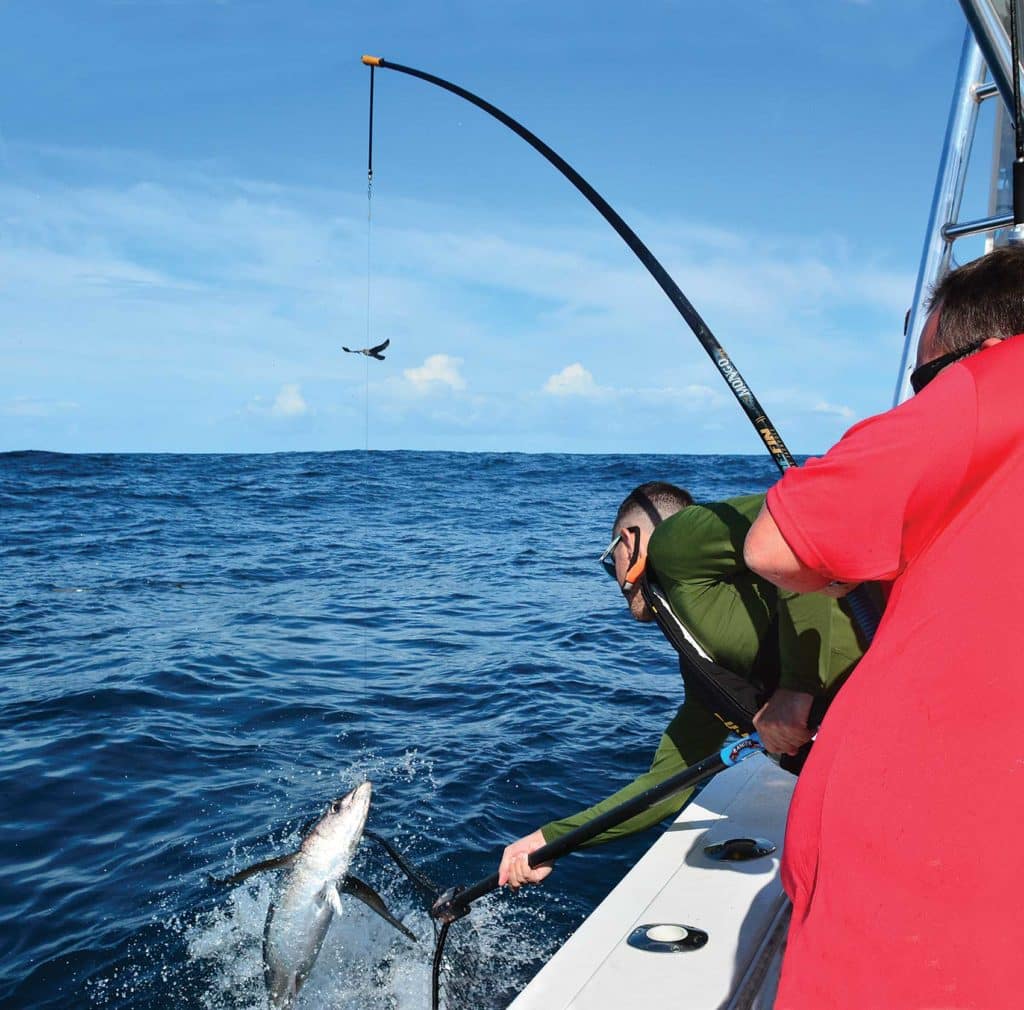
Jack-Pole Party
Colbach got out a 10-foot-long fiberglass pole called a jack pole. There was no reel, only a short length of 100-pound-test fluorocarbon leader and a circle hook. If you’ve ever seen the old, grainy black-and-white films where dozens of men slap down wooden plugs among a huge school of tuna, then yank the hooked fish overhead, you know what comes next. I always thought that looked like a hoot but never thought I would actually try it. Now I had my chance.
Colbach handed me the jack pole and hooked on a live anchovy. Then Van Essen began tossing big scoops of anchovies into the water behind the boat. In seconds, there were dozens of albacore slashing at the baitfish. I lowered my doomed anchovy into the melee. As I watched, almost mesmerized, I saw several tuna flash past my bait in pursuit of other anchovies. Then, seemingly out of nowhere, a fat albacore raced up and inhaled my bait. Colbach hollered, “Jerk!” I yanked up on the heavy rod, lifting the albacore several feet above the water. Standing at the ready, Colbach slipped the net under my fish, and just like that, I had jack-poled my first tuna.
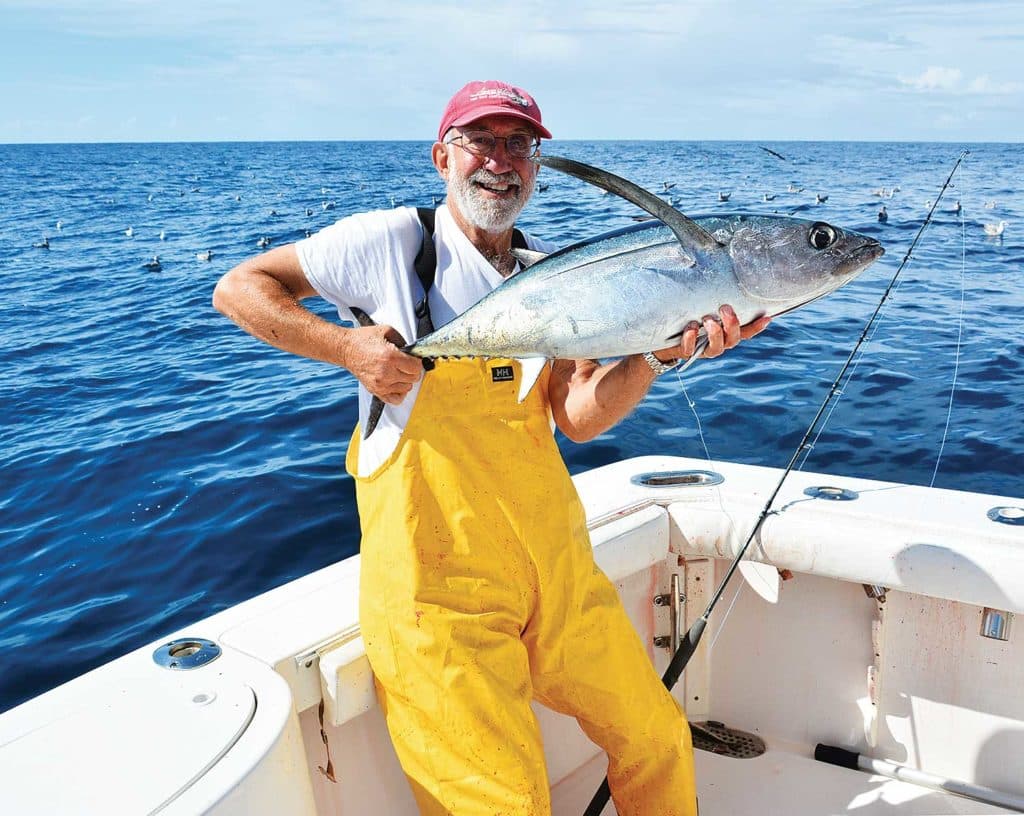
While some of us tried jack-poling, others fished swimbaits using 7-foot baitcasting rods with reels loaded with 50-pound-test braid. The terminal gear consisted of 25-pound-test fluorocarbon and a 4-inch-long swimbait. The technique was simplicity itself: Cast the swimbaits about 100 feet, let them sink as far as possible, then reel like crazy. If there were tuna around, strikes came quickly. Longfin can swim as much as 50 miles per hour, so there is no chance of reeling too fast. If an albacore wants bait, it almost never misses. And because an albacore must eat as much as 25 percent of its body weight each day, it cannot be too picky.
All too soon, we had plugged the boat. The seven of us had landed 46 tuna in three hours. The holds were so full that they would not close properly, and several additional tuna were stacked against the transom.
As we headed back to port, Van Essen prepared one of the fish for fresh sashimi and ceviche. Naturally, Colbach had wasabi, soy sauce and crackers at the ready. Once at the dock, we all dug in and posed for a group photo.
Tuna will never replace the iconic salmon in the Pacific Northwest, but every year, more and more anglers try what I believe is the most exciting angling in the world. I plan to do several Northwest tuna trips every year from now on. If you like fast action, hard-fighting fish and great eating, I suggest you head to the Pacific Northwest’s Albacore Alley.
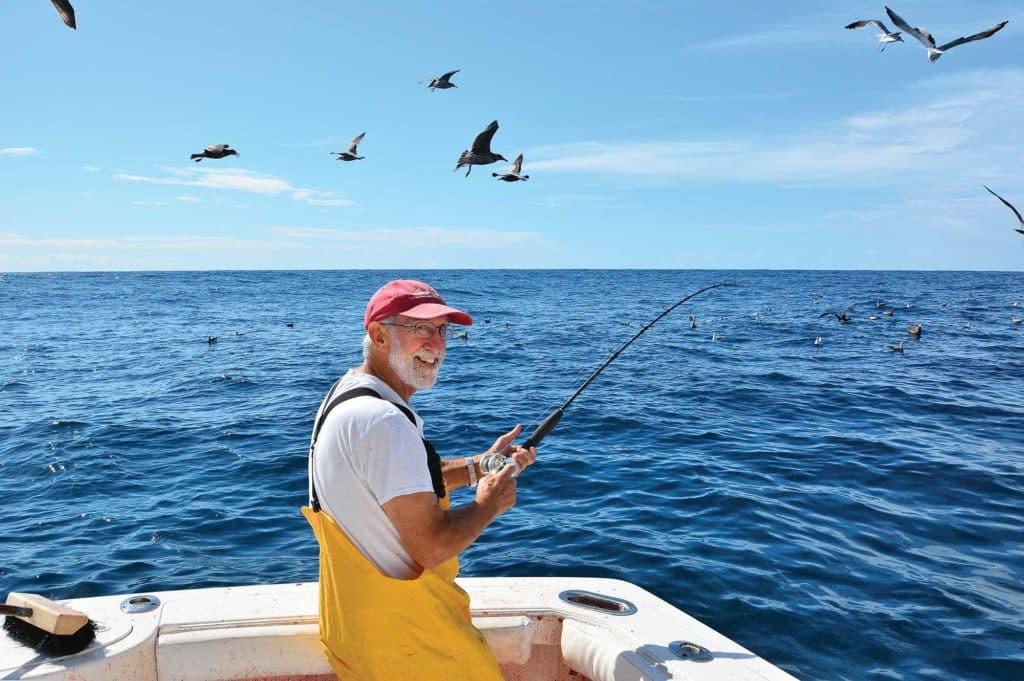
If You Go
Unless you have a seaworthy boat capable of making a run of 10 to 30 miles or more offshore, your best bet is to charter a trip. Ports from Brookings, in southern Oregon, to Tofino, on British Columbia’s Vancouver Island, offer tuna trips, but not all tuna trips are the same. Look for experienced skippers who offer one-day trips in fast boats with lots of live bait.
Typically you will not need to bring any tackle, bait or lures, but many folks enjoy using their own gear. If you bring your own, look for rods in the 6- to 7-foot range rated for 25- to 40-pound-test line. Baitcasting reels such as the Revo Toro Beast are preferred by many anglers, spooled with 50-pound-test braid and with 3 feet of top-quality 30-pound-test fluorocarbon leader.
Hooks should be No. 1 Owner Ringed Flyliners or similar. Also bring an assortment of egg sinkers in the ¼- to 1-ounce range. (Sometimes the bite is improved if you can sink the bait a few feet.) If you want to try tossing swimbaits, a good choice is a 5½- to 6-inch lure in a Pacific anchovy pattern. Color doesn’t seem to be too important, but it’s never a bad idea to also try white or blue-and-white. And don’t forget full rain gear and boots. No matter how nice the weather, you need protection from lots and lots of blood and constant washdown activity.
To book your trip with Shake N Bake_ Charters in Ilwaco, Washington, contact Capt. Mike Colbach.
Ilwaco Tuna Club
The Ilwaco Tuna Club was established in 2012. Its purpose is to provide a place for tuna anglers to share information, knowledge and beer. The club promotes the Washington tuna fishery and tourism in Ilwaco, and it stands ready to help any tuna angler.
The club was started by 12 Ilwaco tuna fanatics, designated flag members. Anyone seeking membership needs only a recommendation from two current members and approval by the majority of the flag members. Members benefit from up-to-date information from local sport and commercial anglers and a 2,100-square-foot on-the-water clubhouse with a beer garden and room for barbecues.
Rooms are available to members for a nominal fee, as are a walk-in freezer, showers and laundry facilities. Each summer, in conjunction with the Surfmen of the Cape Disappointment Coast Guard Station, the club hosts a two-hour seminar on crossing the Columbia River Bar. The free event is open to all.
About the Author
Dave Vedder, a Washington-state native, has been a freelance outdoors writer for more than 30 years, with assignments taking him to 25 countries. His articles and photos have appeared in dozens of outdoors magazines.








